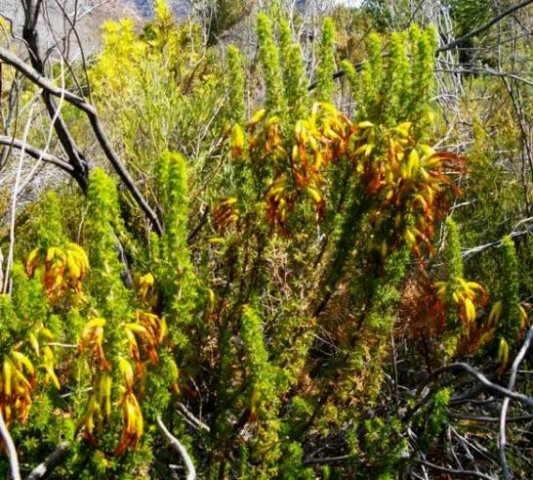Erica coccinea

Author: Ivan Lätti
Photographer: Ivan Lätti
Erica coccinea, also known as tassel heath, and in Afrikaans as hangertjie (little pedant), is a rigid, erect shrub of up to 1,2 m. The variable, short and hard leaves grow in tufts of three, recurving towards the stems.
This is one of the Erica species producing flowers in several colours. This yellow one grows in the Kogelberg. There are also orange, pink, white, red, green or brown flowering plants. Flowers often grow in threes from short side-branchlets near the tips of main branches. The pendulous, pedicelled corollas may be sticky, not always. The corolla tubes are long and curved. The sepals are coloured similarly to the corollas. They appear double from the large bracts, in this case called bracteoles that are also present, the outer ones on top. Blooming carries on all year round.
The specific name, coccinea, is derived from the Latin name, coccum, of the insect known as cochineal, and the word part -ineus that indicates resemblance. Cochineal is a scale insect, Dactylopius coccus from which natural carmine dye is obtained. The specific name refers to the red flowering form of the plant.
Eight stick-like, brown anthers protrude noticeably from the sometimes dark-tipped corolla tube. They are longer than 15 mm. The styles are also exserted, ending in pinhead stigmas.
The species distribution is in the Western Cape, from the Cederberg to the Cape Peninsula and eastwards along the Langeberg Mountains to the Outeniqua Mountains near George. Subsp. coccinea occurs widespread, while subsp. uniflora is restricted to the south coast.
The habitat is fynbos on rocky, sandstone and limestone slopes and flats. The habitat populations of both subspecies are deemed of least concern early in the twenty first century (Manning and Helme, 2024; Curtis-Scott, et al, 2020; Marais, (Ed.), 2017; Manning, 2007; Andrew, 2017; iNaturalist; www.plantzafrica.com; http://redlist.sanbi.org).

